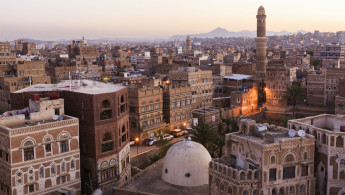Two mosques and Yemen's sectarian divide
If today, Yemen is descending into a sectarian morass, the contrasting stories of two Sanaa mosques suggest sectarian divisions are real but not necessarily as clear-cut as they seem at the moment.
Taysir Mosque's minaret pierces the Sanaa skyline, just as the Zaydi call to prayer pierces the quiet of the Ziraah neighbourhood, a mile from the historic Old City. Not two miles away, the same call to prayer brings the faithful to Handhal Mosque in the Ottoman-era Bir al-Azab neighbourhood.
The minaret at Taysir, however, is painted in the distinctive green and red of the Houthi movement, and the entrance is adorned with the Houthi calling card, its central political slogan: “Death to America, Death to Israel”.
Events at Taysir over the past year provide some indication as to how sectarian tensions in Yemen reached a point where the Houthi movement in September moved on Sanaa and effectively took control.
| Disappointment after the 2011 protests made Yemenis go back to their pre-state identities and entities - Farea al-Muslimi |
Two years ago, a fight broke out after a prayer disagreement between supporters of the Houthi Zaydi movement and the predominantly Sunni Islah party. Guns were pulled, and one Islah supporter later died from his injuries.
(The Islah men in the neighbourhood no longer pray at Taysir. Huda, a few hundred metres down the road, is their mosque of choice.)
Houthi emergence
The emergence of the Houthi movement, a predominantly Zaydi revivalist group with a powerful armed wing, has led to several conflicts, initially with the government, as well as tribal militias affiliated to Islah, a Yemeni party with links to the Muslim Brotherhood, and Salafi groups. The Houthis say that they are a response to the disenfranchisement since the 1962 North Yemen revolution of Zaydis and Hashemites, descendants of the Prophet Muhammed who were often given high class status in the past.
These grievances were also cited ahead of the events of September. But these essentially political issues have been filtering down into society for some time and even dividing families.
The story of Muhammad Abu Taleb is a case in point.
He was 16 when he was killed in June 2013. A Houthi supporter, Abu Taleb had joined a protest that marched to the National Security Agency building in Sanaa. Fighting broke out, and several demonstrators died.
Abu Taleb was promoted by the Houthis as a martyr to their cause, This divided his family, however, with many relatives opposed to the Houthis. A relative, who did not wish to be named, recounted what happened at Muhammad’s funeral.
“Some members of the extended family considered boycotting the funeral, as they did not want to be part of what would inevitably turn into a Houthi protest. Accusations were exchanged concerning the exploitation of Muhammad's death for sectarian reasons, with anti-Houthi relatives questioning why Muhammad had gone to protest with the Houthis.
“Nobody is in the middle, and it's comes down to whether you identify as Shia or Sunni,” the relative added.
This overt sectarian identification is relatively new in Yemen. Zaydis, followers of a branch of Shiism that differs with the dominant Twelver Shiism practiced in places such as Iran and Iraq, have lived in peace with their Sunni co-religionists. Sanaa, and other areas of northern Yemen, are the heartlands of Zaydism, the high mountains providing perfect sanctuary for Zaydis fleeing other parts of the Islamic world 1,000 years ago. The areas were predominantly Zaydi, up until the last few decades, when migrants from other parts of the country, mainly Sunni, arrived. To complete the religious tapestry, Sanaa itself even had a large Jewish population until the mid-twentieth century.
Farea al-Muslimi, a Yemeni writer, believes that the fallout from the popular uprising in 2011, and the failure of the Yemeni state to meet the high hopes of the largely youthful protesters and improve their lives, has led to the emergence of sectarian identities.
“The disappointment of Yemenis after the 2011 protests made them go back to their pre-state identities and entities. Sectarian groups have had a good time recruiting and radicalising people,” al-Muslimi said.
He also pointed to what he calls the weakening of the Yemeni identity, and the breakdown of the social contract between the state and society.
“There was something Yemenis could talk about before religion in the past.”
Two mosques
This weakening of the Yemeni identity can explain the politicisation of Taysir mosque, and its abandonment by most non-Zaydis.
Yet, this is a tale of two mosques.
At Handhal Mosque, Friday prayers are a demonstration of the religious co-existence that locals say has always been the norm.
At midday, the congregation listen to a sermon delivered by an Egyptian sheikh, a graduate of al-Azhar University, the Sunni Islamic world's premier centre of learning. Then, a local imam, a Zaydi, leads the prayer. No one seems to have a particular problem with this arrangement, and Zaydi Shia and Sunnis alike walk out of the mosque arm-in-arm at the end of the prayers, catching up with their neighbours.
With the Houthis apparently in control of much of northern Yemen, and rivals attempting to ratchet up opposition to them by emphasising a Sunni identity, will Handhal become a relic of the past, a memory of an era of co-existence?
Sanaa faces two scenarios, the continuation of relative religious harmony, or different sects marking out their territory. The outcome, Handhal or Taysir, will determine whether the sectarian divide deepens, or whether the tradition of living side by side continues.



